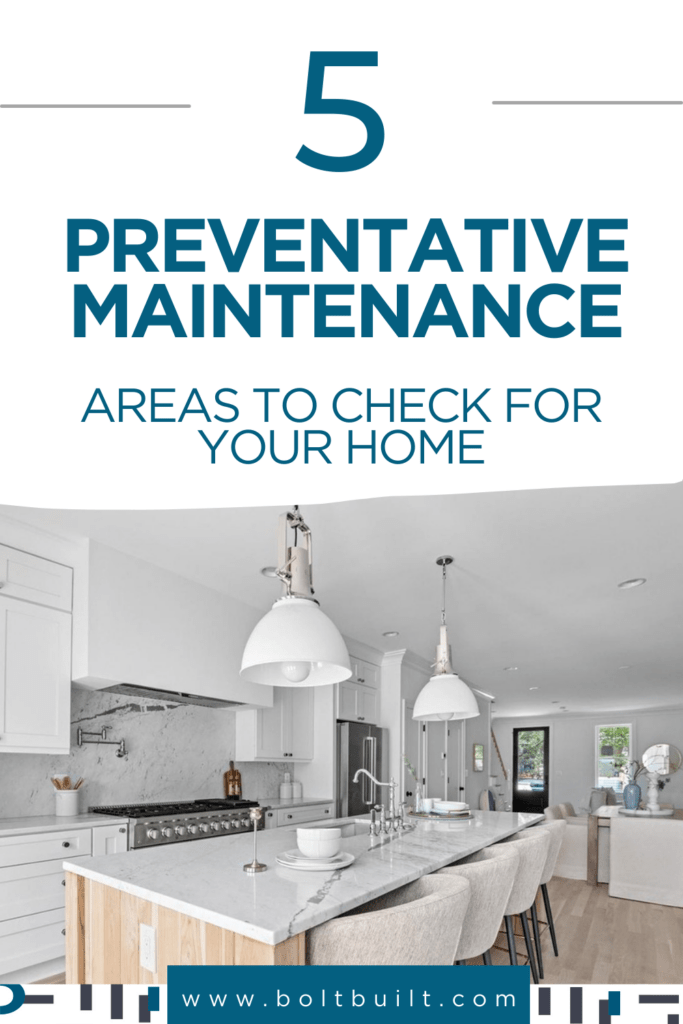Preventative Maintenance for Your Home: 5 Areas to Check
We’ve all heard the expression “An ounce of prevention is worth a pound of cure.” If your home is your biggest investment, as it is for most Americans, then nowhere is this saying more true than when it comes to caring for your house. Repairing and replacing your home’s systems, appliances, and structures can be expensive and time-consuming. But if you inspect and care for your home regularly, you can prevent many costly repairs.
#1. Outside
In the warmer months, we’re all heading outside to soak up the sunshine. As the cold comes in, we’re readying our homes to be snug and warm havens for us. As the seasons change, make sure the outside of your home and your yard are ready.
Make sure your gutters and downspouts are cleaned out regularly–at least twice a year, and more often if you have a lot of trees near your house.
Check that water is directed away from the house and not pooling near the foundation.
Inspect paint and siding. If your paint is chipped or damaged, or the siding is coming loose, it can allow moisture into your walls.
In spring and summer, check sprinklers and make sure they’re upright and not clogged with debris. In the winter, consider draining and storing them so they don’t freeze and crack.
Also in the fall and winter, detach hoses from outside spigots. If you have a shutoff valve, turn off the water and drain the hose bibs. Cover them using insulated bib covers to keep them from freezing.
If you have trees near your home, check and make sure there aren’t branches hanging too close. These could fall in a storm and damage your roof.
Clean and reseal fences and decks once a year to extend the life of the wood and keep them looking great–and ready for a backyard barbeque!
#2. Plumbing
If you’ve ever had a leaky pipe in your house, you know the havoc that water can wreak. Plumbing issues can lead to wall and floor damage, stains, and even dangerous mold growth. But by checking for issues regularly, you’re likely to head off most of these expensive disasters.
Regularly check under sinks for leaks and moisture. You may want to set a reminder on your calendar to check twice a year or so.
Save money and water by inspecting toilet flappers in the backs of your toilets, ensuring that they seal properly. This will keep your toilets from running constantly.
If you have a sump pump, make sure it’s working well to prevent water in the basement.
Inspect sinks, tubs, and showers for small clogs so they won’t get too bad. You can do this by running warm water for 30 seconds and making sure it continues to drain well. If you have a clog, you can try clearing it with boiling water, baking soda and vinegar, a plumber’s snake, or a plastic drain unclogger from a local hardware store.
#3. Appliances and HVAC
Your home has a lot of systems and appliances that help it to run smoothly, and they also need some TLC to keep them working well. While it can be costly to repair or replace these machines, there are definitely things you can do to extend their lives.
Vacuum your refrigerator’s evaporative coils every six months or so. You can do this by unplugging the fridge and removing the bottom panel in the front. Use a vacuum hose to clean dust and debris. Then do the same to the coils on the back of the fridge. This will help your fridge function more efficiently.
While you have your vacuum out, clean air returns and vents of dust and debris.
If you have a tank water heater, flush it once a year, and inspect it every few months for rust or leaks.
Change your air filters regularly! Depending on the size of your home, your town’s air quality, whether or not you have pets, and other factors, you should change it every 90 days or even more frequently. If you notice dust building up around air vents, or it seems to take longer than usual for your home to cool with the AC running, it may be time to change your filter.
#4. Safety
The most important type of preventative maintenance you can do for your home is to make sure it’s safe for yourself, your family, and your friends. It’s estimated that about 358,500 house fires occur each year. Protect your home and family by making sure you’re prepared.
Check all smoke alarms and carbon monoxide detectors twice a year. Many people do this in the spring and fall when the time changes. Test batteries and replace them as necessary.
Clean out your dryer hose at least once a year. A buildup of dryer lint can lead to a house fire.
Have your chimney inspected once a year and repaired if needed.
Make sure you have a working fire extinguisher in the kitchen. Over half of all house fires start in the kitchen. Make sure your extinguisher is pressurized (Push the pin and see if it pops back up–if it does, you’re good to go. Or if it has a pressure gauge, make sure the needle is in the green). Check the expiration date.
Every now and then, check appliance cords, lamp cords, and extension cords for frays or exposed wires.
If you have a fuse that blows often, have an electrician take a look.
While you’re thinking safety, make sure to check that your flashlights have working batteries and you have necessary emergency supplies for natural disasters or long power outages.
#5. Miscellaneous
As you finish your preventative maintenance, make sure you check out these potential problem areas as well.
Inspect and replace weather stripping around windows and doors as needed. These vinyl, rubber, or metal strips help your home stay cool in the summer and warm in the winter by blocking drafts.
Have your roof inspected, particularly if you’ve had a bad storm. You can inspect it from the ground and check for broken or missing shingles, but it’s also good to have a professional inspection now and then.
Check your attic and basement regularly. These are areas that you probably don’t frequent, so issues can build for a while without being noticed. Check for leaks, pests, failing insulation, water stains, etc.
Vacuum the exhaust fans in your bathrooms. A well-working bathroom fan prevents mold and mildew and keeps your bathroom fresh.
Keeping ahead of major home repairs and disasters will ensure that your home looks and functions its best for you and your family. You’ll save money, time, and headaches by doing a little preventative maintenance.
Ready to make your house even better? If you’re considering a bathroom remodel, kitchen remodel, basement remodel, or addition to your DC, Virginia, or Maryland home, contact us today. We’d love to help you improve your home so you can enjoy it more than ever.

